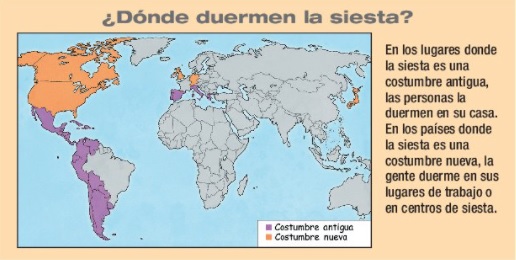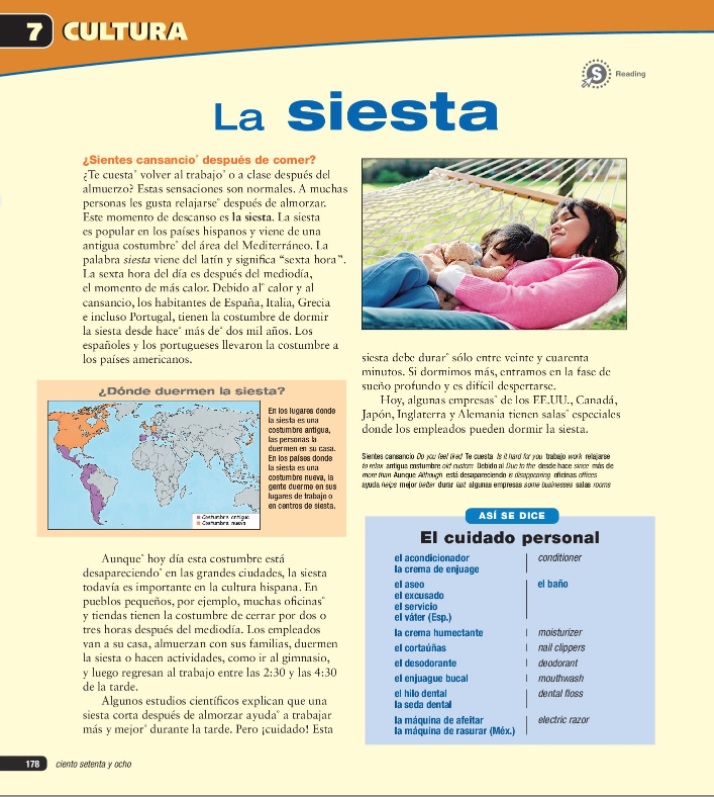Interpretive, Interpersonal, and Presentational Modes of Communication
Exploring Culture
Learning about the cultural practice of Siesta adds valuable insight into what many Hispanic cultures are like. I witnessed this practice firsthand when I was working in Rota, Spain a few years ago. At the time I was a little shocked when I went out for lunch in the afternoon and couldn’t find anyone in the streets and open restaurants where scarce. I never would have imagined that an entire culture, both business and government, would be so family oriented that they set aside their business interests for the benefit of the individual and their family. It was enlightening to learn that this was practiced in many places other than Rota, and that some of the benefits associated with this practice are being pursued even in Western, European, and Asian countries.

Engaging in Communities
Engaging in communities has a great intrinsic value to both the local and global communities. This sentiment is shared in almost every culture from the adages of “It takes a village to raise a child” to the idea of “being the change you seek”. The concepts of community and well-being are inseparable. There isn’t much that embodies the idea of community more than having a common goal or stance. This is perfectly displayed in the comradery displayed through the global interest in futból. As described in La Cultura assignment, support for peoples’ favorite teams can bring even the most distant strangers together to cheer on their team.

Interpersonal Communication
TalkAbroad is an incredible telecollaborative program that allows students to directly communicate with native speakers of the language they are studying. This service allows interactions both on the linguistic and cultural basis that otherwise would not be possible.
I had the opportunity to participate in several interpersonal communication activities throughout the course. There were several exchanges through discussion board posts as well as verbal conversations. Some were spontaneous while others where planned. It was challenging to remember some of the words and phrases during the assignment but the practice itself is what helps me remember and contribute to a working knowledge instead of short-term memory.

Presentational Speaking
We completed several presentational speaking activities where we were given a series of questions or topics in a video and we had to add a video where we answered the questions in Spanish.
This type of activity gave me the opportunity to use many aspects of language that aren’t necessarily tapped into during writing assignments. I had a particularly difficult time “listening” in Spanish and sometimes had to replay the message or instructions several times to understand what was being asked. I think if I did this again, I would try to practice Spanish by speaking to people outside of class or a given assignment. Some people have suggested watching a movie that I have already seen in Spanish with subtitles. The below video is of me responding to a question asked in Spanish.
Presentational Writing
Each unit of our studies had different presentational communication assignments that required us to understand the question, learn the vocabulary, grammar, and context and then apply them directly. This free form of communication was a great learning experience that allowed an expansion of our vocabulary as well as our confidence in our understanding and the ability to effectively communicate in another language.
These assignments varied greatly in topics, complexity, and perspective. Each adding to the knowledge used in the last assignment. I found the more that I used certain words and phrases, the more I was able to recognize them in written and verbal communications as well as identify them faster.
Composition1Interpretive Listening
A critical and integral part of the language learning process is interpretive listening. During this semester, there were listening exercises every week in the homework as well as the unit exams. This type of assignment required that the student listen to a statement, recognize the words, understand the message, then answer the question regarding what was said accordingly.
As previously mentioned, I had a difficult time learning to “listen in Spanish”. I overcame this simply by increasing exposure to the language and repetition. Sometimes I rewatched previous Adventuras videos after the assignments were completed to reinforce the knowledge. Practice makes perfect as they say. The attached video is me responding to a recorded (audio only) question asked in Spanish.
Interpretive Reading
The La Cultura reading assignments were a great opportunity to both exercise interpretive reading and learn about different cultures. We read articles about the Incas, open air marketplaces, the practice of siesta, and the origins of certain fruits.

I enjoyed the reading assignments because they allowed a more practicable perspective to the content being learned. This meant that sometimes there where words and perspectives used that were not introduced yet that made me either learn the meaning from context or look up the word separately. This was most definitely the case for the article La siesta. I had previously heard of the practice but found it interesting that how many countries have done this for a long time compared to countries that are recently adopting the practice.
Image from: Donley, P. R., & Blanco José A. (2018). Aventuras: Primer curso de lengua española. Boston, MA: Vista Higher Learning.